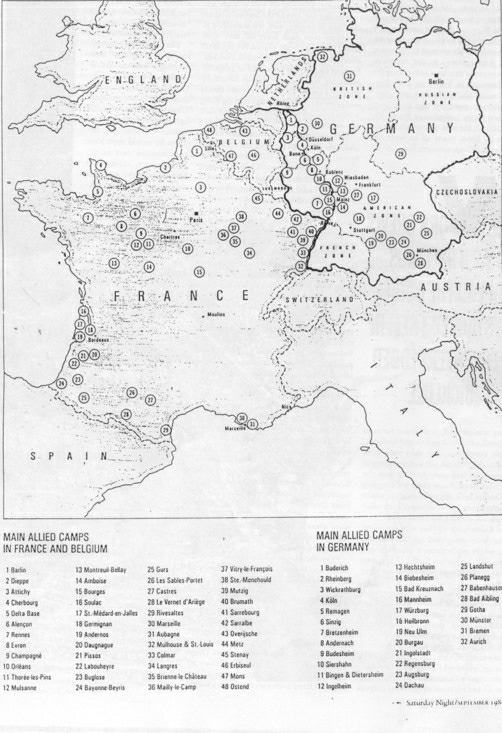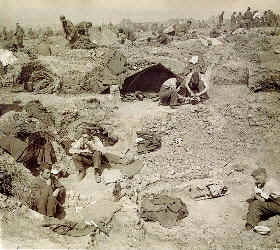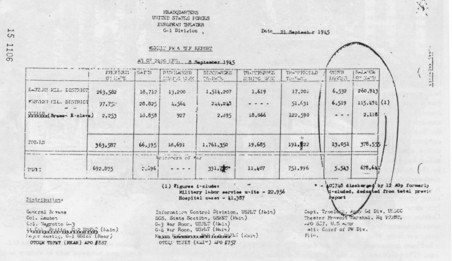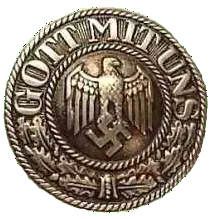The Last Dirty Secret Of World War Two
[As of August 10th, 2024, we have noticed that the website of James Bacque is now defunct. (https://www.jamesbacque.com/) Evidently, James passed on in 2019 at the age of 90. His book, Other Losses, is still available at Amazon.com.]
The Last Dirty Secret Of World War Two
By James Bacque
 James Bacque is a Canadian author and historian, who has written five books on WW2. Two of his books dealt with the allied death camps, and the treatment of civilian Germans from 1945- 1950. Publishers, and libraries, made sure that both works quickly reached obscurity, but now the internet has revived these classics.
James Bacque is a Canadian author and historian, who has written five books on WW2. Two of his books dealt with the allied death camps, and the treatment of civilian Germans from 1945- 1950. Publishers, and libraries, made sure that both works quickly reached obscurity, but now the internet has revived these classics.
Call it callousness, call it reprisal, call it a policy of hostile neglect: a million Germans taken prisoner by Eisenhower's armies died in captivity after the surrender.
In the spring of 1945, Adolf Hitler's Third Reich was on the brink of collapse, ground between the Red Army, advancing westward towards Berlin, and the American, British, and Canadian armies, under the overall command of General Dwight Eisenhower, moving eastward over the Rhine. Since the D-Day landings in Normandy the previous June, the western Allies had won back France and the Low Countries, and some Wehrmacht commanders were already trying to negotiate local surrenders. Other units, though, continued to obey Hitler's orders to fight to the last man. Most systems, including transport, had broken down, and civilians in panic flight from the advancing Russians roamed at large.
Hungry and frightened, lying in grain fields within fifty feet us, awaiting the appropriate time to jump up with their hands in the air": that's how Captain H.F. McCullough of the 2nd Anti-Tank Regiment of the 2nd Canadian Division described the chaos of the German surrender at the end of the Second World War. In a day and a half, according to Field Marshal Bernard Montgomery, 500,000 Germans surrendered to his 21st Army Group in northern Germany. Soon after V-E Day — May 8, 1945 — the British-Canadian catch totalled more than 2-million. Virtually nothing about their treatment survives in the archives in Ottawa or London, but some skimpy evidence from the International Committee of the Red Cross, the armies concerned, and the prisoners themselves indicates that almost all continued in fair health. In any case, most were quickly released and sent home, or else transferred to the French to help in the post-war work of reconstruction. (The French army had itself taken fewer than 300,000 prisoners.)
Like the British and Canadians, the Americans suddenly faced astounding numbers of surrendering German troops: the final tally of prisoners taken by the U.S. army in Europe (excluding Italy and North Africa) was 5.25-million. But the Americans responded very differently.
Among the early U.S. captives was one Corporal Helmut Licbich, who had been working in an anti-aircraft experimental group at Peenemünde on the Baltic. Liebich was captured by the Americans on April 17, near Gotha in central Germany. Forty-two years later, he recalled vividly that there were no tents in the Gotha camp, just barbed-wire fences around a field soon churned to mud. The prisoners received a small ration of food on the first day but it was then cut in half. In order to get it, they were forced to run a gauntlet. Hunched over, they ran between lines of American guards who hit them with sticks as they scurried towards their food. On April 27, they were transferred to the U.S. camp at Heidesheim farther west, where there was no food at all for days, then very little. Exposed, starved, and thirsty, the men started to die. Liebich saw between ten and thirty bodies a day being dragged out of his section, B, which at first held around 5,200 men. He saw one prisoner beat another to death to get his little piece of bread. One night, when it rained, Liebich saw the sides of the holes in which they were sheltered, dug in soft sandy earth, collapse on men who were too weak to struggle out. They smothered before anyone could get to them. Liebich sat down and wept.."I could hardly believe men could be so cruel to each other."
Typhus broke out in Heidesheim about the beginning of May. Five days after V-E Day, on May 13, Liebich was transferred to another U.S. POW camp, at Bingen Rüdesheim in the Rhineland near Bad Kreuznach, where he was told that the prisoners numbered somewhere between 200,000 and 400,000, all without shelter, food, water, medicine, or sufficient space.
Soon he fell sick with dysentery and typhus. He was moved again, semiconscious and delirious, in an open-topped railway car with about sixty other prisoners: northwest down the Rhine, with a detour through Holland, where the Dutch stood on bridges to smash stones down on the heads of the prisoners. Sometimes the American guards fired warning shots near the Dutch to keep them off. Sometimes not. After three nights, his fellow prisoners helped him stagger into the huge camp at Rhcinberg, near the border with the Netherlands, again without shelter or food.

A German newspaper, Rhein-Zoltung, has identified this uncaptioned U.S. Army photograph of German POWs as: camp at Sinzig-Remagen, spring, 1945
When a little food finally did arrive, it was rotten. In none of the four camps had Liebich seen any shelter for the prisoners. The death rate in the U.S. Rhineland camps at this point, according to surviving data from a medical survey, was about thirty per cent per year. A normal death rate for a civilian population in 1945 was between one and two per cent.
One day in June, through the hallucinations of his fever, Liebich saw "the Tommies" coming into the camp. The British had taken over Rheinberg, and that probably saved his life. At this point, Liebich, who is five-foot-ten, weighed 96.8 pounds.
EISENHOWER HIMSELF SIGNED THE REQUEST TO CREATE A PRISONER CATEGORY NOT COVERED BY THE GENEVA CONVENTION
According to stories told to this day by other ex-prisoners of Rheinberg, the last act of the Americans before the British took over the camp was to bulldoze one section level while there were still living men in their holes in the ground.
Under the Geneva Convention, three important rights are guaranteed prisoners of war: that they will be fed and sheltered to the same standard as base or depot troops of the Capturing Power; that they can send and receive mail; and that they will be visited by delegates of the International Committee of the Red Cross (ICRC) who will report in secret on their treatment to a Protecting Power. (In the case of Germany, as the government disintegrated in the closing stages of the war, Switzerland had been designated the protecting power.)
In fact, German prisoners taken by the U.S. Army at the end of the Second World War were denied these and most other rights by a series of specific decisions and directives stemming mainly from U.S. Army headquarters at SHAEF — Supreme Headquarters, Allied Expeditionary Force. General Dwight Eisenhower was both supreme commander of SHAEF — all the Allied armies in north-western Europe — and the commanding general of the U.S. forces in the European theatre. He was subject to the Combined Chiefs of Staff (CCS) of Britain and the U.S., to the U.S. Joint Chiefs of Staff ( JCS), and to the policy of the U.S. government, but in the absence of explicit directives — to the contrary or otherwise — ultimate responsibility for the treatment of the German prisoners in American hands lies with him.
"God, I hate the Germans," Eisenhower wrote to his wife, Mamie, in September, 1944. Earlier, in front of the British ambassador to Washington, he had said that all the 3,500 or so officers of the German General Staff should be "exterminated."
In March, 1945, a message to the Combined Chiefs of Staff signed and initialled by Eisenhower recommended, creating a new class of prisoners — Disarmed Enemy Forces, or DEF’s — who, unlike Geneva-defined prisoners of war, would not be fed by the army after the surrender of Germany. This would be a direct breach of the Geneva Convention. The message, dated March 10, argues in part: "The additional maintenance commitment entailed by declaring the German Armed Forces prisoners [sic] of war which would necessitate the provision of rations on a scale equal to that of base troops would prove far beyond the capacity of the Allies even if all German sources were tapped." It ends: "Your approval is requested. Existing plans have been prepared upon this basis."
On April 26, 1945, the Combined Chiefs approved the DEF status for prisoners of war in American hands only: the British members had refused to adopt the American plan for their own prisoners. The Combined Chiefs stipulated that the status of disarmed German troops be kept secret.
By that time, Eisenhower's quartermaster general at SHAEF, General Robert Littlejohn, had already twice reduced rations to prisoners and a SHAEF message signed "Eisenhower" had reported to General George Marshall, the U.S. Army chief of staff, that the prisoner pens would provide "no shelter or other comforts. . . ."
The problem was not supplies. There was more than enough materiel stockpiled in Europe to construct prison-camp facilities. Eisenhower's special assistant, General Everett Hughes, had visited the huge supply dumps at Naples and Marseille and reported: "More stocks than we can ever use. Stretch as far as eye can see." Food should not have been a problem, either. In the U.S., wheat and corn surpluses were higher than they had ever been, and there was a record crop of potatoes. The army itself had so much food in reserve that when a whole ware houseful was dropped from the supply lists by accident in England it was not noticed for three months. In addition, the International Committee of the Red Cross had over 100,000 tons of food in storage in Switzerland. When it tried to send two trainloads of this to the American sector of Germany, U.S. Army officers turned the trains hack, saying their warehouses were already overflowing with ICRC food which they had never distributed.
Nonetheless it was through the supply side that the policy of deprivation was carried out. Water, food, tents, space, medicine — everything necessary for the prisoners was kept fatally scarce. Camp Rheinberg, where Corporal Liebich would fetch up in mid-May, shivering with dysentery and typhus, had no food at all when it was opened on April 17. As in the other big "Rhine meadow" camp, , opened by the Americans in mid-April, there were no guard towers, tents, buildings, cooking facilities, water, latrines, or food.
George Weiss, a tank repairman who now lives in Toronto, recalls of his camp on the Rhine: "All night we had to sit up jammed against each other. But the lack of water was the worst thing of all. For three and a half days, we had no water at all. We would drink our own urine. . . ."
Private Heinz T. (his surname is withheld at his request) had just turned eighteen in hospital when the Americans walked into his ward on April 18. He and all his fellow patients were taken out to the camp at Bad Kreuznach in the Rhineland, which already held several hundred thousand prisoners. Heinz was wearing only a pair of shorts, shoes, and a shirt.
Heinz was far from the youngest in the camp, which also held thousands of displaced German civilians. There were children as young as six among the prisoners, as well as pregnant women, and men over sixty. At the beginning, when trees still grew in the camp, some men managed to cut off limbs to build a fire. The guards ordered the fire put out. In many of the enclosures, it was forbidden to dig holes in the ground for shelter. "All we had to eat was grass," Heinz remembers.
Charles von Luttichau was convalescing at home when he decided to surrender voluntarily to U.S. troops about to occupy his house. He was taken to Camp Kripp, on the Rhine near Remagen.
 "We were kept in crowded barbed-wire cages in the open with scarcely any food."
"We were kept in crowded barbed-wire cages in the open with scarcely any food."
The POW camps clustered all along the Rhine mark the final successful Allied thrust into Germany. The U.S. Army officially took 5.25-million prisoners he recalled recently.
"More than half the days we had no food at all. On the rest, we got a little K ration. I could see from the package that they were giving us one-tenth of the rations that they issued to their own men. . . . I complained to the American camp commander that he was breaking the Geneva Convention, but he just said, 'Forget the Convention. You haven't any rights.'
WORK CREWS REMOVED DOG TAGS, STRIPPED THE BODIES, AND STACKED THEM IN LAYERS INTERBEDDED WITH QUICKLIME
"The latrines were just logs flung over ditches next to the barbed-wire fences. Because of illness, the men had to defecate on the ground. Soon, many of us were too weak to take off our trousers first. So our clothing was infected, and so was the mud where we had to walk and sit and lie down. In these conditions, our men very soon started to die. Within a few days, some of the men who had gone healthy into the camp were dead. I saw our men dragging many bodies to the gate of the camp, where they were thrown loose on top of each other onto trucks, which took them away."
Von Luttichau's mother was American and he later emigrated to Washington, D.C., where he became a historian and wrote a military history for the U.S. Army. He was in the Kripp camp for about three months.
Wolfgang Iff, who was imprisoned at Rheinberg and still lives in Germany, reports that, in his subsection of perhaps 10,000 prisoners, thirty to forty bodies were dragged out every day. A member of the burial work party, 1ff says he helped haul the dead from his cage out to the gate of the camp, where the bodies were carried by wheelbarrow to several big steel garages. There Iff and his team stripped the corpses of clothing, snapped off half of each aluminum dog tag, spread the bodies in layers of fifteen to twenty, with ten shovelfuls of quicklime over each layer till they were stacked a metre high, placed the personal effects in a bag for the Americans, then left. Some of the corpses were dead of gangrene following frostbite. (It was an unusually wet, cold spring.) A dozen or more others had grown too weak to cling to the log flung across the ditch for a latrine, and had fallen off and drowned.
The conditions in the American camps along the Rhine in late April were observed by two colonels in the U.S. Army Medical Corps, James Mason and Charles Beasley, who described them in a paper published in 1950: "Huddled close together for warmth, behind the barbed wire was a most awesome sight — nearly 100,000 haggard, apathetic, dirty, gaunt, blank-staring men clad in dirty field grey uniforms, and standing ankle-deep in mud. . . . The German Division Commander reported that the men had not eaten for at least two days, and the provision of water was a major problem — yet only 200 yards away was the River Rhine running bankfull."
On May 4, 1945, the first German prisoners of war in U.S. hands were transferred to DEF status. The same day, the U.S. War Department banned mail to or from the prisoners. (When the International Committee of the Red Cross suggested a plan for restoring mail in July, it was rejected.)
On May 8, V-E Day, the German government was abolished and, simultaneously, the U.S. State Department dismissed Switzerland as the protecting power for the German prisoners. (Prime Minister Mackenzie King of Canada protested to the Foreign Office in London the parallel removal of the Swiss as protecting power in British-Canadian camps, but was squelched With this done, the State Department informed the International Committee of the Red Cross that, since there was no protecting power to report to, there was no longer any point in visiting the camps.
Front then on, prisoners held by the U.S. Army had no access to any impartial observer, nor could they receive food parcels, clothing, or medicines from any relief agency, or letters froth their kin.
General George Patton's U.S. Third Army was the only army in the whole European theatre to free significant numbers of captives during May, saving many of them from probable death. Both Omar Bradley and General J.C. H. Lee, Commander Communications Zone (Coin Z) Europe, ordered a release of prisoners within a week of the war's end, but a SHAD' order signed "Eisenhower" countermanded them on May 15.
That same day, according to a minute of their meeting, General Eisenhower and Prime Minister Churchill talked about reducing prisoner rations. Churchill asked for an agreement on the scale of rations for prisoners, because he would soon have to announce cuts in the British meat ration and wanted to make sure that the prisoners "as far as possible . . . should be fed on those supplies which we could best spare." Eisenhower replied that he had already "given the matter considerable attention," but was planning to re-examine the whole thing to see "whether or not a further reduction was possible." He told Churchill that POWs had been getting 2,200 calories a day. (The U.S. Army Medical Corps considered 2,150 an absolute minimum subsistence level for sedentary adults living under shelter: U.S. troops were issued 4,000 calories a day.) What he did not tell Churchill was that the army was not feeding the DEF’s at all, or was feeding them far less than those who still enjoyed prisoner-of-war status.
Rations were reduced again soon after this: a direct cut was recorded in the Quartermaster Reports. But indirect cuts were taking place as well. One was the effect of extraordinary gaps between prisoner strength as given on the ration lists and official "on hand" counts, and between the on-hand counts and the actual number of prisoners in the camps.
The meticulous General Lee grew so worried about the discrepancies that he fired off a challenging cable from his headquarters in Paris to SHAEF headquarters in Frankfurt:
"This Headquarters is having considerable difficulty in establishing adequate basis for requisitioning rations for prisoners of war currently held in Theatre. . . In response to inquiries from this Headquarters ... several varying statements of number of prisoners held in Theater have been published by SHAEF."
He then cites the latest SHAEF statement:
"Cable . . . dated 31 May states 1,890,000 prisoners of war and 1,200,000 disarmed German forces on hand. Best available figures at this Headquarters show prisoners of war in Com Z 910,980, in Com Z transient enclosures 1,002,422 and in Twelfth Army GP 965,135, making a total of 2,878,537 and an additional 1,000,000 disarmed German forces Germany and Austria."
The situation was astounding: Lee was reporting a million more men in the U.S. Army camps in Europe than SHAEF said it had on its books. But he was wrestling with the wind: he had to base his issue of food on the number of prisoners on hand supplied to him by SHAEF G-3 (Operations).
Given the general turmoil, fluctuating and inaccurate tallies were probably inevitable, but more than 1-million captives can actually be seen disappearing between two reports of the Theatre Provost Marshal, issued on the same day, June 2. The last in a series of daily reports from the TPM logs 2,870,400 POWs on hand at June 2. The first report of the new weekly series, dated the same day, says that there are only 1,836,000 on hand. At one point in the middle of June, the prisoner strength on the ration list was shown as 1,421,559, while on Lee's and other evidence there were probably almost three times that number.
 It was U.S. Army policy to provide "no shelter or other comforts" In the prisoner enclosures: the men lived In holes In the earth which they dug themselves.
It was U.S. Army policy to provide "no shelter or other comforts" In the prisoner enclosures: the men lived In holes In the earth which they dug themselves.
Spreading the rations thinner was one way to guarantee starvation. Another was accomplished by some strange army bookkeeping during June and July. A million prisoners who had been receiving at least some food because of their nominal POW status lost their rights and their food when they were secretly transferred to the DEF status. The shift was made deliberately over many weeks, with careful attention paid to maintaining plausible balances in SHAEF's weekly POW and DEL; reports. (The discrepancy between those —shifter from POW status during the period from June 2 to July 28 and those "received" in the DEF status is only 0.43 per cent.) The reclassification to DEF did not require any transfer of men to new camps, or involve any new organization to get German civilian supplies to them. The men stayed where they were. All that happened was that, by the clatter of a typewriter, their skimpy bit of U.S. Army food was stopped.
The effect of a policy arranged through accountancy and conveyed by winks and nods — without written orders — was first to mystify, then to frustrate, then to exhaust the middle-rank officers who were responsible for POWs. A colonel in the Quartermaster Section of the advance U.S. fighting units wrote a personal plea to Quartermaster General Robert Littlejohn as early as April 27: "Aside from the 750 tons received from Fifteenth Army, no subsistence has been received nor do I expect any. What desirable Class II and IV [rations] we have received has been entirely at the sufferance of the Armies, upon personal appeal and has been insignificant in relation to the demands which are being put upon us by the influx of prisoners of war."
Rumours of conditions in the camps f:111 through the U.S. army. "Boy, those camps were bad news," said Benedict K. Zobrist, a technical sergeant in the Medical Corps. "We were warned to stay as far away as we could." In May and early June of 1945, a team of U.S. Army Medical Corps doctors did survey some of the Rhineland camps, holding just over 80,000 German POWs. Its report is missing from the appropriate section of the National Archives in Washington, but two secondary sources reproduce some of the findings. The three main killers were diarrhoea and dysentery (treated as one category), cardiac disease, and pneumonia. But, straining medical terminology, the doctors also recorded deaths from "emaciation" and "exhaustion." And their data revealed death rates eighty times as high as any peacetime norm.
Only 9.7 per cent to fifteen percent of the prisoners had died of causes clearly associated with lack of food, such as emaciation and dehydration, and "exhaustion." -But the other diseases, directly attributable to exposure, overcrowding, filth, and lack of sanitation, were undoubtedly exacerbated by starvation. As the report noted, "Exposure, overcrowding of pens and lack of food and sanitary facilities all contributed to these excessive [death) rates." The data, it must be remembered, were taken from the POW camps, not from the DEF camps.
By the end of May, 1945, more people had already died in the U.S. camps than would die in the atomic blast at Hiroshima.
On June 4, 1945, a cable signed "Eisenhower" told Washington that it was "urgently necessary to reduce the number of prisoners at earliest opportunity by discharging all classes of prisoners not likely to be required by Allies." It is hard to understand what prompted this cable. No reason for it is evident in the massive cable traffic that survives the period in the archives in London, Washington, and Abilene, Kansas. And far from ordering Eisenhower to take or hold on to prisoners, the Combined Chiefs' message of April 26 had urged him not to take in any more after V-E Day, even for labour. Nonetheless more than 2-million DEFs were impounded after May 8.
During June, Germany was partitioned into zones of occupation and in July, 1945, SHAEF was disbanded. Eisenhower, revert- Mg to his single role as U.S. commanding general in Europe, became military governor of the U.S. zone. He continued to keep out Red Cross representatives, and the U.S. Army also informed American relief teams that the zone was closed to them. It was closed to all relief shipments as well — until December, 1945, when a slight relaxation came into effect.
Also starting in July, the Americans turned over between 600,000 and 700,000 German captives to the French to help repair damages done to their country during the war. Many of the transferees were in five U.S. camps clustered around Dietersheim, near Mainz, in the section of Germany that had just come under French control. (Most of the rest were in U.S. camps in France.)
On July 10, a French army unit took over Dietersheim and seventeen days later a Captain Julien arrived to assume command. His report survives as part of an army inquiry into a dispute between Julien and his predecessor. In the first camp he entered, he testified to finding muddy ground "peopled with living skeletons," sonie of whom died is he watched. Others huddled under bits of cardboard which they clutched although the July day was hot. Women lying in holes in the ground stared up at him with hunger oedema bulging their bellies in gross parody of pregnancy; old men with long grey hair watched him feebly; children of six or seven with the raccoon rings of starvation looked at him from lifeless eyes. Two German doctors in the "hospital" were trying to care for the dying on the ground under the hot sky, between the marks of the tent that the Americans had taken with them. Julien, who had fought against the Germans with his regiment, the 3eme Regiment de Tirailleurs Algeriens, found himself thinking in horror: "This is just like the photographs of Buchenwald and Dachau."
There were 103,500 people in the five camps round Dietersheim and among them Julien's officers counted 32,640 who could do no work at all. These were released immediately. In all, two-thirds of the prisoners taken over by the French that summer from American camps in Germany and in France were useless for reparations labour. In the camp at Sainte-Marthe, 615 of 700 captives were reported to be unable to work. At Erbiseul near Mons, Belgium, according to a written complaint, twenty- five per cent of the men received by the French were "dechets ," or garbage.
In July and August, as U.S. Quartermaster Littlejohn signalled to Eisenhower in due course, the Army food reserves in Europe grew by thirty-nine percent.
On August 4, a one-sentence order signed "Eisenhower" condemned prisoners of war still on hand in the U.S. camps to DEE status: "Effective immediately all members of the German forces held in U.S. custody in the American zone of occupation in GERMANY will be considered as disarmed enemy forces and not as having the status of prisoner of war." No reason was given. Surviving weekly tallies suggest the dual classification was preserved, but, for the POWs now being treated as DEFs, the death rate quadrupled within a few weeks, from .2 per cent per week to .8 percent.
Long time DEFs were dying at nearly five times that rate. The official "Weekly PW & DEF Report" for the week ending September 8, 1945, still exists in the U.S. National Archives in Washington. It shows an aggregate of 1,056,482 prisoners being held by the U.S. Army in the European theatre, of whom about two-thirds are identified as POWs. The other third — 363,587 men — are DEFs. During that one week, 1.3,051 of them died.
In November, 1945, General Eisenhower succeeded George Marshall as U.S. Army chief of staff and returned to the U.S. In January, 1946, the camps still held significant numbers of captives but the U.S. had wound down its prisoner holdings almost to zero by the end of 1946. The French continued holding hundreds of thousands through 1946, but gradually reduced the number to nothing by about 1949. During the 1 950s, most non-record material relating to the U.S. prison camps was destroyed by the Army.
Eisenhower had deplored the Germans' useless defence of the Reich in the last months of the war because of the waste of life. At least ten times as many Germans — undoubtedly 800,000, almost certainly more than 900,000, and quite probably over 1-million — died m the French and American camps as were killed in all the combat on the Western Front m northwest Europe from America's entry into the war in 1941 through to April, 1945



























